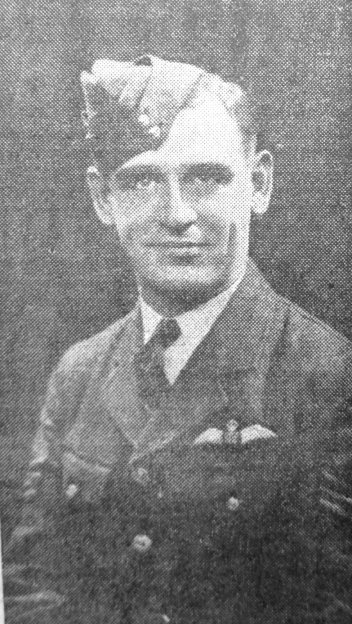Mexborough & Swinton Times, March 9, 1940
Kilnhurst R.A.F. Victim
Colliery Manager’s Son Killed
Talented Pilot
Pilot Officer R. S. S. Black.

The first Kilnhurst man to be killed while serving with H.M. Forces is Pilot Officer Robert S. S. Black, younger son of Mr. and Mrs. David Black, of Beechwood House, who died when his plane crashed during a training flight at one of the R.A.F. home training stations. Pilot Officer Black had been flying since he was 16 and was called up in the Royal Air Force Volunteer Reserve on the outbreak of war.
He is the son of Mr. David Black, manager of Kilnhurst Colliery, and was born in Lanarkshire. Educated at Hamilton Academy, Lanarkshire, he learned flying at Renfrew Aerodrome, Glasgow, upon leaving school. He became a member of the Scottish Flying Club, and was flying at the age of 16. Pilot Officer Black gained his “A” licence at the age of 17.
He then came to Leeming, in the North of England and got his “B” licence for blind flying there, shortly afterwards joining the R.A.F. Volunteer Reserve.
When his father came to Kilnhurst, Pilot Officer Black joined the Doncaster Flying Club, and won a cup for being the best flier of his year in 1936. He had previously won a similar award in 1934 at Glasgow.
Pilot Officer Black was employed at Metro-Vickers Ltd., Sheffield, for a short period, when he came to stay in this district, and was called up as a Sergeant Pilot when war broke out. He was killed while carrying out machine gun practice in power dives, his machine plunging into the earth from a great height. The mishap occurred shortly after he had gained a commissioned rank.
An inquest was held at Peterborough on Tuesday.
The Inquest
An inquest into the fatality was held on Tuesday. The two occupants of the plane were Robert Shiria Spratt Black and James Fife Wales, aged 20, of Mewslade, Mizenway, Cobham, Surrey.
The inquest was held at Oundle Police Station on Tuesday, when events relating to the crash were described by two farm workers.
Thomas Alfred Pell, farm labourer, of Nassington, near Peterborough, said that he heard the crash when sitting in his home having tea, and on hurrying outside saw the wrecked plane in an adjoining field. It had crashed upside down and debris was scattered for a considerable distance. Witness added that he ran to the plane and looked under it to see if he could be of any assistance. He failed to locate any of the occupants, but he had not much time to investigate as there was an explosion and the machine burst into flames. He narrowly escaped being burnt. The police were fetched.
Questioned by the Coroner (Mr. J. C. Parker) witness said he saw no smoke or flames until he got to the aeroplane and the explosion occurred.
Percy Hill, tractor driver, of Wood-newton, said he saw the aeroplane flying very high at first, but as it came in his direction it began losing altitude. He thought it was going to make a forced landing, and then he heard the noise of the engines increase, the plane “tipped up” in the air and fell straight towards the ground.
The hollow of the field in which he was working obstructed his view, and he did not actually see it land, but on running to the field beyond he saw that it had crashed and was on fire.
Flight Lieut. Maurice William Moore said that he visited the scene of the crash and there saw the remains of a service aircraft which had left its aerodrome that afternoon. noon, after being flown several times previously that day Witness added that as far as he knew the machine was mechanically perfect when it took off for the flight during, which Black was the pilot, and Wales was acting as observer. it was a dual controlled machine and both men were pilots. In answer to the Coroner, witness said he identified the bodies, but the aircraft was in such a damaged state that it was absolutely hopeless for him to give any idea as to the cause of the crash. Flight-Lieutenant Gordon Primrose Smith, M.O.H., said that from his examination of the bodies he was satisfied that the deaths were instantaneous , due to injuries received in the crash and were not the result of burns.
The Coroner returned a verdict of “Accidental Death.”
The Funeral.
The interment of Pilot Officer Black, and the other victim of the crash, who were buried side by side, took place at Peterborough Cemetery on Wednesday with military honours. The coffins, draped with Union Jacks, and with the men’s officers’ caps resting upon them were carried on Army lorries through the streets to the cemetery and were then carried by men of the R.A.F. through a guard of honour composed of R.A.F. Men.
A Presbyterian service was conducted over Pilot Officer Black, and the other victim was accorded a Church of England service. The many officers present saluted as the coffins were lowered into the grave, three volleys were fired into the air, and the “Last Post” was sounded Relatives and friends of Pilot Officer Black who attended included: Mr. and Mrs. David Black (parents). Mr. and Mrs. Thomas Black (brother and sister-in-law). Miss Ethel Redmill (fiancee, of Rotherham). Mr. W. A. Willis (general manager of Tinsley Park Collieries), and Mr. John Willis. Representatives of Metro-Vickers (Sheffield works) were present, and there were also representatives from Kilnhurst Colliery. Many floral tributes were received.